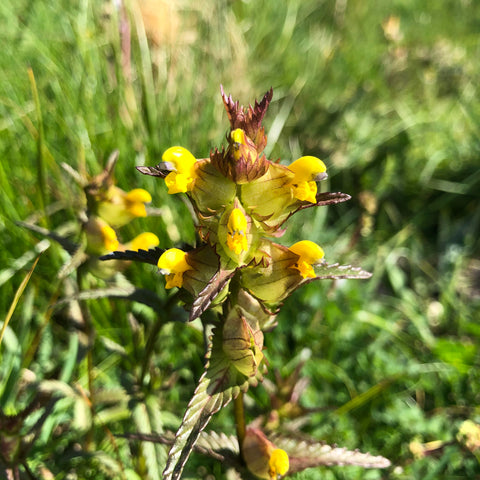
Yellow Rattle in 2020: A story of our times
Share
Yellow Rattle, Rhinanthus minor, is an annual wildflower which often - but far from always - used to be found in meadows. It has attracted a lot of attention recently because it parasitises, among other plants, grasses. Euphrasia does a similar thing. Grasses do well in higher fertility soils, and the kind of aggressive grass cultivars in your lawn are bred to do particularly well period.
This makes converting lawns into wildflower meadows kind of tricky, and explains the enthusiasm for Rhinanthus. It can certainly help, for sure, but very typically of our times folk tend to see it as a magic bullet. It seems like an easy solution to a complicated problem. If only life were that simple.
Rattle can certainly help in the right circumstances, with the right grasses and the right management, but it's just not THE answer to making meadows. Nature doesn't work like that. Much more important is management and the soil you're working with. The same seed mix sown on two sites for two clients will produce quite different results after 10 years.
Not only is there no such thing as a unique and simple solution to making a wildflower meadow, but nature can go wrong too. Rattle seed can rot on the ground if waterlogged. It has a long germination period and won't germinate at all if it doesn't get cold enough for long enough. It can be eaten by sheep, or not reach the ground when it falls, or just not like your site - it's not like sowing F1 carrot seed. And then there are issues with bought seed; it might be too old or damaged in processing.
It's complicated.
And while we find "complicated" increasingly difficult, Yellow Rattle in 2020 has another lesson for us - learning to live with climate change.

Everyone might want Rattle this year, but few can have it - and those that can will have to pay for it. Call it a consequence of weather or climate change, but this year's harvest has been poor. Some seeds rotted over the wet winter. Others failed to germinate because it was too mild. Of the plants which did make it, many (as the photo) were stunted by the late May frost many of us had, which meant the seed is impossible to harvest. That's if it's dry enough to harvest at all between recent torrential downpours. Such seed as is for sale is very expensive indeed.
We're struggling to supply our customers at the moment, and as we do these two lessons go around my head. I'm very happy to sell people Rhinanthus seed, of course, but we do need other strategies to make our new wildflower meadows work. We need to learn to live without it.

